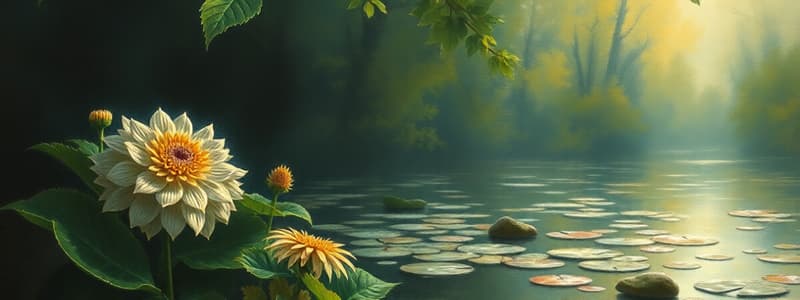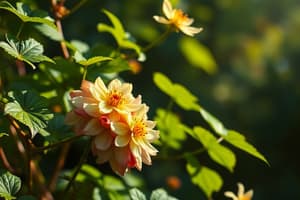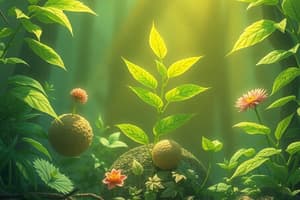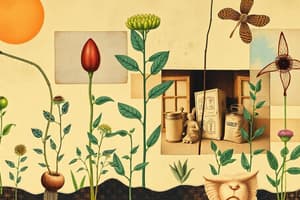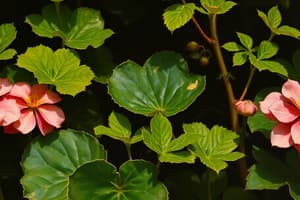Podcast
Questions and Answers
The components of food that are necessary for our body are called ______.
The components of food that are necessary for our body are called ______.
nutrients
The mode of nutrition in which organisms make food themselves from simple substances is called ______ nutrition.
The mode of nutrition in which organisms make food themselves from simple substances is called ______ nutrition.
autotrophic
Animals and most other organisms that take in food prepared by plants are called ______.
Animals and most other organisms that take in food prepared by plants are called ______.
heterotrophs
Leaves are the food factories of plants, and all raw materials must reach the ______ for photosynthesis.
Leaves are the food factories of plants, and all raw materials must reach the ______ for photosynthesis.
The tiny pores present on the surface of leaves, surrounded by guard cells, are called ______.
The tiny pores present on the surface of leaves, surrounded by guard cells, are called ______.
Water and minerals are transported to the leaves through vessels which run like pipes throughout the root, the stem, the branches and the leaves, forming a continuous path or ______.
Water and minerals are transported to the leaves through vessels which run like pipes throughout the root, the stem, the branches and the leaves, forming a continuous path or ______.
The green pigment in leaves that helps capture the energy of sunlight is called ______.
The green pigment in leaves that helps capture the energy of sunlight is called ______.
Since the synthesis of food occurs in the presence of sunlight, the process is called ______.
Since the synthesis of food occurs in the presence of sunlight, the process is called ______.
In the absence of ______, there would not be any food and the survival of almost all living organisms would be impossible.
In the absence of ______, there would not be any food and the survival of almost all living organisms would be impossible.
Plants synthesize carbohydrates through the process of ______, using carbon, hydrogen, and oxygen.
Plants synthesize carbohydrates through the process of ______, using carbon, hydrogen, and oxygen.
Plants cannot absorb nitrogen in its gaseous form; soil has certain bacteria that convert it into a usable form and release it into the soil, these bacteria are called ______.
Plants cannot absorb nitrogen in its gaseous form; soil has certain bacteria that convert it into a usable form and release it into the soil, these bacteria are called ______.
Plants that do not have chlorophyll use the ______ mode of nutrition, depending on food produced by other plants.
Plants that do not have chlorophyll use the ______ mode of nutrition, depending on food produced by other plants.
The plant on which Cuscuta climbs and takes readymade food from is called the ______.
The plant on which Cuscuta climbs and takes readymade food from is called the ______.
Insect-eating plants are termed ______ plants, digesting insects to absorb nutrients.
Insect-eating plants are termed ______ plants, digesting insects to absorb nutrients.
Organisms that take in nutrients from dead and decaying matter exhibit ______ nutrition and are called saprotrophs.
Organisms that take in nutrients from dead and decaying matter exhibit ______ nutrition and are called saprotrophs.
Flashcards
What are Nutrients?
What are Nutrients?
Components of food that are necessary for our body, including carbohydrates, proteins, fats, vitamins, and minerals.
What is Nutrition?
What is Nutrition?
The mode of taking food by an organism and its utilization by the body.
What is Autotrophic Nutrition?
What is Autotrophic Nutrition?
A mode of nutrition where organisms make their own food from simple substances.
What are Autotrophs?
What are Autotrophs?
Signup and view all the flashcards
What are Heterotrophs?
What are Heterotrophs?
Signup and view all the flashcards
What are cells?
What are cells?
Signup and view all the flashcards
What is the cell membrane?
What is the cell membrane?
Signup and view all the flashcards
What is the nucleus?
What is the nucleus?
Signup and view all the flashcards
What is cytoplasm?
What is cytoplasm?
Signup and view all the flashcards
What are stomata?
What are stomata?
Signup and view all the flashcards
What is chlorophyll?
What is chlorophyll?
Signup and view all the flashcards
What is photosynthesis?
What is photosynthesis?
Signup and view all the flashcards
What are Saprotrophs?
What are Saprotrophs?
Signup and view all the flashcards
What is Saprotrophic Nutrition?
What is Saprotrophic Nutrition?
Signup and view all the flashcards
What is symbiosis?
What is symbiosis?
Signup and view all the flashcards
Study Notes
- Food is essential for all living organisms
- Carbohydrates, proteins, fats, vitamins, and minerals are components of food
- These components are called nutrients
- Nutrients are necessary for the body
- All living organisms require food
- Plants can create their own food
- Animals, including humans, cannot create their own food
- Animals get food from plants or other animals
- Humans and animals are directly or indirectly dependent on plants
Mode of Nutrition in Plants
- Plants are the only organisms that can prepare food for themselves
- They use water, carbon dioxide, and minerals
- Raw materials are present in their surroundings
- Nutrients enable living organisms to build bodies, grow, repair damaged parts, and provide energy
- Nutrition is the mode of taking food by an organism and its utilization by the body
- Autotrophic nutrition is when organisms make food themselves from simple substances
- Plants are called autotrophs
- Animals and most other organisms take in food prepared by plants
- These are called heterotrophs
Photosynthesis
- Leaves are the food factories of plants
- All raw materials must reach the leaf
- Water and minerals present in the soil are absorbed by the roots and transported to the leaves
- Carbon dioxide from the air is taken in through tiny pores
- These pores are present on the surface of leaves and are called stomata
- Water and minerals are transported to the leaves by vessels
- Vessels run like pipes throughout the root, stem, branches, and leaves
- Vessels form a continuous path for nutrients to reach the leaf
- Leaves have a green pigment called chlorophyll
- Chlorophyll helps leaves capture the energy of sunlight
- This energy synthesizes food from carbon dioxide and water
- Synthesis of food in the presence of sunlight is called photosynthesis
- Chlorophyll, sunlight, carbon dioxide, and water are necessary for photosynthesis
- Photosynthesis is a unique process on Earth
- Solar energy is captured by the leaves and stored in the plant in the form of food
- The sun is the ultimate source of energy for all living organisms
- In the absence of photosynthesis, there would be no food
- The survival of almost all living organisms depends directly or indirectly on the food made by plants
- Oxygen is essential for the survival of all organisms
- Photosynthesis also takes place in other green parts of the plant, like green stems and branches
- Desert plants have scale- or spine-like leaves to reduce water loss by transpiration
- These plants have green stems that carry out photosynthesis
- All organisms' food is produced during photosynthesis
- Without photosynthesis, life would be impossible on Earth
- Chlorophyll-containing cells of leaves use carbon dioxide and water to synthesize carbohydrates in the presence of sunlight
- The process can be represented in an equation: Carbon dioxide + water --(sunlight/chlorophyll)--> Carbohydrate + oxygen
- During photosynthesis, oxygen is released
- The presence of starch in leaves indicates the occurrence of photosynthesis
- Starch is also a carbohydrate
Synthesis of Plant Food
- Carbohydrates are made of carbon, hydrogen, and oxygen
- Carbohydrates synthesize other food components, such as proteins and fats
- Proteins are nitrogenous substances containing nitrogen
Other Modes of Nutrition
- Some plants do not have chlorophyll
- These plants cannot synthesize food
- These plants depend on food produced by other plants
- They use the heterotrophic mode of nutrition
- Cuscuta (Amarbel) is a plant without chlorophyll
- It takes readymade food from the plant it climbs, called the host
- Cuscuta is a parasite because it deprives the host of valuable nutrients
- Insect-eating plants are called insectivorous plants
- When an insect lands in the pitcher, the lid closes, and the insect gets entangled in the hair
- The insect is digested by digestive juices, and its nutrients are absorbed
Saprotrophs
- Fungi are organisms that have a different mode of nutrition
- Fungi absorb nutrients from the bread
- This mode of nutrition, in which organisms take in nutrients from dead and decaying matter, is called saprotrophic nutrition
- Organisms with saprotrophic nutrition are called saprotrophs
- Fungi also grow on pickles, leather, clothes, and other articles left in hot and humid weather for a long time
- During the rainy season, fungi spoil many things
- Fungal spores are generally present in the air
How Nutrients are Replenished in the Soil
- Farmers spread manure or fertilizers in fields, and gardeners use them in lawns or pots to replenish nutrients
- Plants absorb minerals and nutrients from the soil
- Amounts of nutrients in the soil decline, hence replenishment
- Fertilizers and manures contain nutrients such as nitrogen, potassium, and phosphorus
- These nutrients need to be added to enrich the soil
- Crop plants absorb a lot of nitrogen, and the soil becomes deficient
- Plants need nitrogen in a soluble form
- Rhizobium can take atmospheric nitrogen and convert it into a usable form
- Rhizobium cannot make its own food
- Rhizobium lives in the roots of gram, peas, moong, beans, and other legumes and provides them with nitrogen
- In return, the plants provide food and shelter to the bacteria
- This is a symbiotic relationship
- This association is significant for farmers because they can reduce the use of nitrogenous fertilizer
- Most pulses are obtained from leguminous plants
- Most plants are autotrophs
- Only a few plants are parasitic or saprotrophic
- These derive nutrition from other organisms
- All animals are categorized as heterotrophs
- Animals depend on plants and other animals for food
Studying That Suits You
Use AI to generate personalized quizzes and flashcards to suit your learning preferences.
